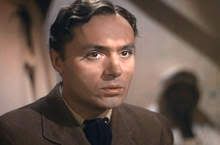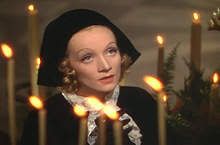Turner Classic movies is airing the love story The Garden of Allah this Tuesday (February 19) at 3:15 AM ET. The story itself is pretty treacly, and worthy of the Lifetime Channel; it might be even more of a "chick flick" than The Great Lie. But there are technical reasons for recommending this movie. Charles Boyer plays the male lead, a monk in a Catholic monastery in North Africa who happens to be the only person who knows the secret of making a liqueur that his monastery produces. One day, however, the gorgeous Marlene Dietrich visits the monastery, and he, so smitten by her, leaves the monastery so that he can live out in the regular world and marry her. Although the two fall in love, she's a devout Catholic, and eventually discovers that he's the monk who knows how to make that liqueur which is no longer being made, so she feels it's her duty to make him go back to the monastery and take up his vows again....
Charles Boyer plays the male lead, a monk in a Catholic monastery in North Africa who happens to be the only person who knows the secret of making a liqueur that his monastery produces. One day, however, the gorgeous Marlene Dietrich visits the monastery, and he, so smitten by her, leaves the monastery so that he can live out in the regular world and marry her. Although the two fall in love, she's a devout Catholic, and eventually discovers that he's the monk who knows how to make that liqueur which is no longer being made, so she feels it's her duty to make him go back to the monastery and take up his vows again....
I told you that this is a retch-inducing storyline. But the movie has a saving grace: it's one of the earliest features to be produced in the more advanced "three-strip" Technicolor process. I'm not an expert on the technical aspects of filmmaking, but if you want a good history of the Technicolor process, you can't do better than to visit the Wide-screen Museum web-site. Basically, however, in the 1920s, the Technicolor company, in its attempt to create color movies, used a process generally called "two-strip" (although this is technically inaccurate). The film stock was run through two filters to produce a color positive, a red filter, and a blue-green filter. The upshot is that most of the reds turned out rather pinkish, while dark greens were relatively accurate, with other shades turning into a somewhat pastel bluish green. Yellow was the one other color that was reproduced with relative accuracy, as yellow is the result of "mixing" equal amounts of red and green light. (Remember that the primary colors of light are red, green, and blue, different from the primary colors of pigment, where yellow replaces green as one of the primary colors; if you look at an old cathode-ray tube TV you'll note that it has narrow red, green, and blue vertical lines that produced the colors.) Two-strip Technicolor wasn't that successful, partly because it wasn't that accurate, and partly because it was expensive, and once talking pictures were introduced, the studios didn't want to spend large sums of money making pictures in color.
In the early 1930s, the Technicolor company started to perfect the process that would become known as "three-strip", with three strands of film being used to create the ultimate positive. This process was first used in Walt Disney animated shorts, and a few one- and two- reelers by the studios, until 1935, when the movie Becky Sharp was released. The color in Becky Sharp wasn't the greatest, with blues, purples, and oranges still not being displayed all that well.
But The Garden of Allah, released one year later, is different.  The color is absolutely brilliant, as you can see in this photo of Dietrich. Dietrich was somewhat worried about how Technicolor would make her look, but when she did some screen tests and discovered that it didn't make her look bad, she went ahead with the movie. And it's not just Dietrich who looks lovely on screen; everything does. Boyer looks handsome too, and watch for the shots of the night sky in the desert. The midnight blue is an unbelievably deep blue.
The color is absolutely brilliant, as you can see in this photo of Dietrich. Dietrich was somewhat worried about how Technicolor would make her look, but when she did some screen tests and discovered that it didn't make her look bad, she went ahead with the movie. And it's not just Dietrich who looks lovely on screen; everything does. Boyer looks handsome too, and watch for the shots of the night sky in the desert. The midnight blue is an unbelievably deep blue.
"Three-strip" Technicolor was used until the mid-1950s, when other processes became available which were cheaper and more convenient. See the Reel Classics site for a synopsis. Sadly, however, the newer processes weren't as vibrant as the three-strip Technicolor. Today, of course, it seems standard practice for big-budget blockbusters to use sets that are decked out in a hundred shades of black, and that have denatured faces. Thankfully, though, the dazzling brilliance of three-strip Technicolor can still be seen by watching the great old movies.
Let's Talk The Oscar Short Lists
2 hours ago

No comments:
Post a Comment